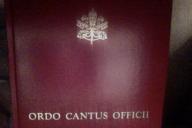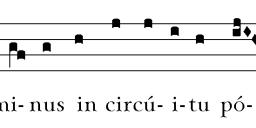Revised Ordo Cantus Officii
-
So I got my Revised Ordo Cantus Officii from the Vatican (which was awesome, like early Christmas). But when I went to pray Vespers from it tonight, I found this reference to an Antiphon without a reference to where it's from. I've looked through all three volumes of the new Antiphonale Monasticum, and the Antiphonale Romanum II, but to no avail. I have no idea where to find this antiphon. Does it not exist yet? Do I have to wait until Solesmes publishes another book? The abbreviation "Rom" is designated "melody ex tradition cantos « veteris romani » sumpta. Where is this antiphon?

 Photo on 12-16-15 at 12.08 AM.jpg640 x 426 - 93K
Photo on 12-16-15 at 12.08 AM.jpg640 x 426 - 93K
 Photo on 12-16-15 at 12.09 AM #2.jpg640 x 426 - 56K
Photo on 12-16-15 at 12.09 AM #2.jpg640 x 426 - 56K -
This is something the previous OCO was filled with: antiphons with no music. I have never understood why someone would propose that, and to my astonishment, the latest edition of the OCO didn't fix this. Still many antiphons have been chosen without any musical notation at hand. How are we supposed to sing the Liturgy of the Hours in Latin this way?
When I'm back home (Thursday), I will see if I can find a reference for this antiphon. -
Things like this are the reason I stopped singing OF Office. I'll still pray OF, but for singing, I stick with the EF.
-
Yeah, I was hoping that the new OCO would correct this too. Alas! I'm inclined to shoot an email to Solesmes, but they haven't responded to my last email as of yet (I hope that's not because of my very rusty french). I'd contact the CDW too, but know of no contact information for them.
-
I don't see the chant notation given in any modern books, either.
The 1977 Thesaurus Liturgiae Horarum Monasticae lists it, without the first word "et," as an option for the 3rd antiphon for "Schema B" Tuesday nones (p103); as an option for 2nd antiphon for "Schema C" Thursday of Week 2 vespers (p116); and as an option for 3rd antiphon for "Schema D" Monday nones (p123).
The 1983 Ordo Cantus Officii lists it, again without the first word "et," as an antiphon for the complimentary psalmody at sext. (Number 130, on page 422[66]).
The CANTUS database has it, and only with "et," once:
the fourth antiphon for vespers on Tuesdays per annum, in a 12th-century Old Roman antiphoner. ("Biblioteca Apostolica Vaticana, San Pietro B.79," folio 50r.) Here:
http://cantusdatabase.org/node/257820
An image can be seen here:
http://digi.vatlib.it/view/MSS_Arch.Cap.S.Pietro.B.79/0001?page_query=50r&navmode=struct&action=pagesearch&sid=431258aa8d5a369450d463ef8883a102
But I can't read the notation, so that's all I got. : ) -
I searched the antiphon in Laus Divina by Frans Kok, and it also refers to S. Pietro as the source manuscript.
It should not be too difficult to transcribe the music; the FA and DO (?) lines are indicates in red and yellow.
But really: are we supposed to go through scanned manuscripts and transcribe the music ourselves just to be able to sing daily office in Latin?Thanked by 1BruceL -
My best guess at MS above. I'm reading a Fa clef on the lower red line, and (thus) a Do clef on the upper (faint) yellow-ish line. That lines up (more or less) with the Tone VIII differentia that follows the red P (for psalm). You may question my reading of the neumes (and ignore my editorial dots).

 EtDominusInCircuitu.jpg1279 x 275 - 69K
EtDominusInCircuitu.jpg1279 x 275 - 69K -
Most of the antiphons for the day time hours have already published in Les Heures Grégoriennes. This one, too:

 gregorio56771c7d8a4085.24439826.pdf7K
gregorio56771c7d8a4085.24439826.pdf7K
Welcome to the MusicaSacra Forum!
To participate in the discussions on Catholic church music, sign in or register as a forum member, The forum is a project of the Church Music Association of America.
Categories
- All Discussions21,177
- General Music Discussion8,246
- Job Openings205
- Management of Music Programs851
- Choral Matters534
- Church Documents and Rubrics526
- CMAA Notes304
- Events722
- For Newcomers: Read First26
- Sacred Polyphony547
- Hymnody873
- Gregorian Chant: General2,703
- ↳ Graduale Romanum and Liber Usualis369
- ↳ Graduale Simplex60
- ↳ Semiology63
- Vernacular Plainsong696
- Anglican Use and Anglican Chant68
- Organ, Other Instruments and Repertoire436
- New Composition/Works in Progress1,295
- Recordings234
- Music for Hispanic Ministry159
- Music Education: Children211
- Music Education: General222
- News Items245
- Positions Wanted3
- General Discussion: Catholicism740
- Amusements177
- General Discussion1,035
- Opinions119




